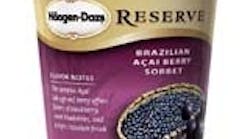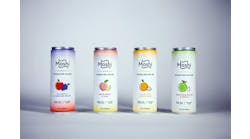Açai is certainly hot right now. The small dark-purple drupe of the palm Euterpe oleracae hails from northern Brazil and is known by natives as “iça-çai,” which means “fruit that cries.”
The idea of strongly colored natural superfoods with high levels of antioxidants has driven consumer interest in plants and ingredients from South America. For centuries, berries from the açai palm have been eaten with breakfast to provide a daylong boost of energy, build the immune system and treat infections.
It was not until the 1950s that these health benefits, including cancer-fighting properties, began to be investigated. Today, açai is used as an ingredient in a variety of products, from freeze-dried fruit snacks to cosmetics to flavored vodka.
Sorbet or sherbet is a frozen dessert made from sweetened water and iced fruit, as opposed to ice cream which is made from dairy products. Sorbet is believed to have been invented by the Roman Emperor Nero during the first century A.D. Buckets of snow were transferred by runners down the Appian Way and mixed with honey and wine in the great banquet halls of Rome.
The U.S. is the second largest consumer of ice cream per capita (10 quarts per person) with 93 percent of households consuming ice cream. This consumption is driven mostly by households with children -- 34 percent of households with children consume four or more quarts of ice cream per month. Only 20 percent of households without children eat that much.
Nestle’s Haagen Dazs looked at this market and the tidal wave of health expectations from consumers and considered how to create an intuitively healthy indulgent dessert focused on the some of the biggest demographic growth segments, baby boomers and households without children.
Understanding the marketplace
The overall ice cream category has been generally flat for more than a decade. So the fact sales were down 2.9 percent in 2006, according to Information Resources Inc., comes as no surprise. Even though Americans spend approximately $21 billion a year on ice cream, nearly two-thirds of it is eaten away from home, according to the Intl. Dairy Foods Assn. Coupled with the reality of its loss leader status in the supermarket, the picture tends to look grim for this category.
The one bright spot is sales of reduced-fat varieties grew 15 percent between January and June 2006. Many consumers still believe a low-fat diet is one of the best definitions of healthy eating. Sorbet sits very squarely in this arena, and can still be premium. Sorbet can sound decadent and delicious without necessarily calling to attention its low-fat content.
The top flavors of ice cream are vanilla, chocolate, butter pecan and strawberry. In order to clearly call attention to the fact this product is different, the flavors had to be premium and unique. When consumers are asked about what would make them feel better about their cravings for ice cream, low-fat, calcium, antioxidants and all-natural ingredients are the properties they are looking for – according to our own Crave It! 2007 studies. Using the acai berry makes the product a win on two of these properties.
Right after published research regarding the açai berry's cancer-fighting ability in 2005, global launches of products containing açai tripled. Consumers heard the message that acai was healthy. The acai berry contributes enormously to the economy of the Amazon Rainforest region. Unlike the deforestation that occurs with the harvest of hearts-of-palm, the twice-yearly açai harvest does not destroy the trees that produce it.
Many by-products also are profitable, including the sale of palm fronds for hats, baskets and roof thatch, whole seeds for jewelry and souvenirs, ground seeds for livestock feed and the outer bark, which is an excellent fuel source. It all makes this sorbet a premium healthy indulgence that gives back to the environment.
Our CraveIt!, Deal with it!, It's Convenient and Healthy You! studies indicate refreshment, indulgence, relaxation and fun are among the roles ice cream plays. When people eat ice cream, they want it to taste good, look good and be from the right brand. Consuming ice cream makes people feel happy. When consumers have to make choices about ice cream, they choose multiple additives (nuts, chocolate, etc.), real ingredients, melt in you mouth and multiple flavors.
Key trends in the ice cream category are:
Co-branding and flavors: Co-branding to deliver distinctive flavors (candy, cookie, fruit and flavors) has been a strong trend. Novelties and ultrapremium products have teamed with candy, coffee and chocolate manufacturers to deliver branded flavors of ice cream (think Starbucks coffee flavors, Dove chocolate, M&M’s inclusions). New flavors that are multidimensional have driven the marketplace the past few years.
Fat level: Giving the consumer multiple fat-level choices has provided some growth for the category. Regular ice cream accounts for the largest share of the frozen dessert market, at 63.8 percent. Reduced-fat, light, low-fat and nonfat ice cream account for 23.5 percent of the market, followed by frozen yogurt (4.3 percent), water ice (4.3 percent), sherbet (3.6 percent) and other (0.5 percent), according to 2006 figures from Information Resources Inc.
Novelties: Following the focus on portion control in other categories, novelties have driven growth in the category. Smaller sizes and individual portions have been key to this sub-category.
The experience
The Haagen-Dazs Reserve series is available in one-pint cartons for about $5.50. We evaluated the Brazilian Açai Berry Sorbet. Other varieties are Amazon Valley Chocolate, Pomegranate Chip, Hawaiian Lehua Honey & Sweet Cream and Toasted Coconut Sesame Brittle Ice Cream. In bars, there’s also a Pomegranate & Dark Chocolate Bar.
Since açai was an unfamiliar flavor to us, we were not certain what to expect. Though the description on the carton suggests the flavors of blueberry and blackberry, most of our tasters picked up a very cooked blackberry flavor. One of our more progressive tasters, a frequent consumer of a popular brand of açai juice, simply said “it tastes like açai.”
A more complete description on the product website states: “The nutritious and complex açai berry offers this tantalizing sorbet notes of sweet blueberries, wild blackberries and a hint of grape, all delivered through a velvety, pear-like texture.” Although we had not thought to liken the slightly gritty texture to pears before, it does make sense and is more apparent as the product softens after a few minutes out of the freezer.
What is interesting to note is the website description was the only mention we could find of the health benefits. Nothing about that on the package. But, as we stated earlier, there is no need for that. We are already “in the know,” or should be, if we are buying this product.
As for other health attributes, the product has 120 calories per serving, just 2g of fat and zero saturated fat.
The packaging speaks loudly of a premium product within. A black banded label and a gold and regal deep purple carton are luxurious in their own right. And while the product is low in fat (typical for sorbet) and contains a gram of fiber, no attention is called to either of these facts.
Does the product deliver?
Haagen-Dazs is about delivering a premium experience. Even though ice cream is definitely a mood food, consumers would rather not hear how they should feel, but instead experience that feeling as they eat it.
Haagen-Dazs Reserve Brazilian Açai Berry Sorbet is for people “in the know.” People so hip and knowledgeable that the company doesn’t need to take up valuable space on the carton or even much on the website to educate them on just how good the antioxidant punch of açai really is. You are cool. You already know that. Instead, you are interested in what wine and cheese you might serve it with (the website actually suggests Gorgonzola in a whole what cracker and Lambrusco). The experience was of a premium sorbet -- better melt-in-your-mouth qualities than most sorbets, but not as premium as ice cream
How to make the idea bigger: One reason açai is so powerful is the color itself. More and more research indicates purple fruits and vegetables pack the best antioxidant punch. Depending on which test is being used, açai, blueberries and blackberries occupy the top spot in antioxidant power.
There’s also the “antioxidant cascade effect,” which indicates antioxidants are most effective when combined with other antioxidants. So often these fruits are mixed. While a single berry is important for consumers to intuitively relate antioxidants to the sorbet, adding more antioxidants via the cascade effect would heighten the health aspects.
Providing portion control sizes may be another opportunity to play off consumers’ ideas about health, yet still be able to deliver the premium melt-in-your-mouth experience.
Rating: The product does deliver on most of the promises for those consumers looking for an intuitively healthy indulgence. This gives people who want to eat healthy a way to experience some indulgence, without giving up anything.
Market potential: Great. This frozen dessert is at once indulgent, premium and intuitively healthy -- close to the Holy Grail for consumers.


